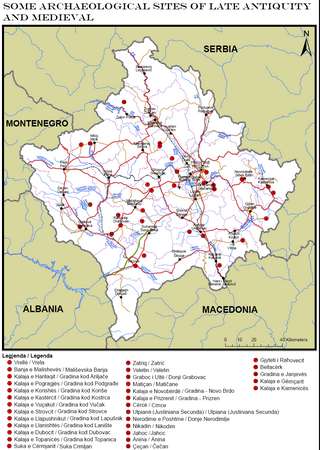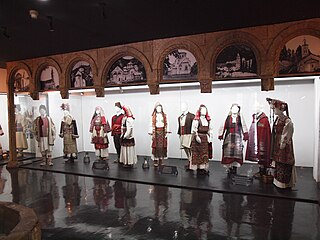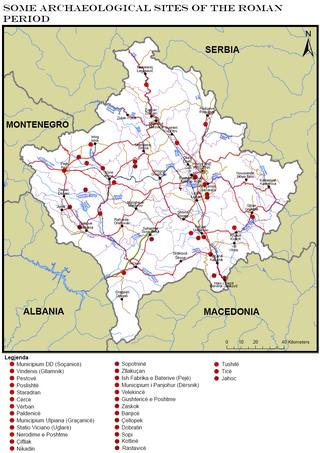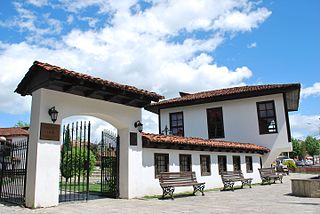
Our Lady of Ljeviš is a 14th-century Serbian Orthodox church in the town of Prizren, in southern Kosovo. Since 2006, the church is part of the UNESCO World Heritage Site named Medieval Monuments in Kosovo.

Vendenis was an ancient city in Dardania in Kosovo. Among three road stations that were constructed in Dardania during the Roman Period, Statio Vindenis, is one of the identified stations. This archaeological site is set at the area of the village of Gllamnik, Municipality of Podujeva. The site is located approximately 5 kilometres south of Podujeva.
Tourism in Kosovo is characterized by archaeological heritage from Illyrian, Dardanian, Roman, Byzantine, Serbian and Ottoman times, traditional Albanian and Serbian cuisine, architecture, religious heritage, traditions, and natural landscapes. Kosovo is situated in south-eastern Europe. With its central position in the Balkans, it serves as a link in the connection between central and south Europe, the Adriatic Sea, and Black Sea.

Archaeology of Kosovo as a field of study and research was started in the second half of the 20th century. Kosovo's field of archaeology has developed in tandem with the historical study, studies of ancient authors' sources, classic philological studies, theological data research, topographic studies and ground survey, analysis of toponyms, deciphering of epigraphic and historiographic data. First data about antique monuments in Kosovo, were documented from the end of the 19th until the beginning of the Second World War, a time period when Kosovo was visited by researchers, guides, and archaeologists such as: Evans, Boue, Hahn, Kanitz, Tomaschek, Domaschevski, Arpad, Vulic, Jirecek, Patsch, Domenico Mustilli, etc.

Part of series of articles upon Archaeology of Kosovo

Kosovo is a partially recognized state and disputed territory located in the Balkan Peninsula in Southeastern Europe. The majority of Kosovars are ethnically Albanian. Kosovo has an expansive cultural heritage, including monuments, clothing items, museums, and traditional food.
Part of series of articles upon Archaeology of Kosovo

The Roman heritage sites in Kosovo represent a multitude of monuments of material and spiritual culture, which reflect the Roman period in this region. Among them, a special place is occupied by those that represent the development of art, such as the plastic monuments that are more frequent, and at the same time occupy an important place, because with the presentation of figures in relief and with numerous inscriptions they speak to us enough for this period.
Monuments of Kosovo comprise all the monuments that are located in Kosovo.

Part of a series of articles upon Archaeology of Kosovo

Viciana or Station Viciano was a Roman road station of unclear location, somewhere in Kosovo field.
Poslishtë is a village in the Prizren Municipality of Kosovo. The location is known for the nearby archaeological site, which was discovered in 2010.
The strategic position of the region of Mitrovica in the middle of two great rivers Ibar and Sitnica and its mineral wealth in Albanik, made this location populated since prehistoric period. This region was populated by Illyrians, respectively members of the Dardan tribe. The first data for the archaeological sites in the region of Mitrovica, begin with the researches of Sir Artur John Evans, who was the first to pinpoint the Roman town of the Municipium Dardanourm. In the archaeological sites of the region of Mitrovica were found traces and objects from different periods such as; Neolithic, Roman, late antiquity and medieval period. Objects and figurines include: fortress vestiges, necropolis, Terpsichore figure, statues, sarcophagus, altar, jewelry, etc.
The architecture of Kosovo dates back to the Neolithic period and includes the Copper, Bronze and Iron Ages, Antiquity and the Medieval period. It has been influenced by the presence of different civilizations and religions as evidenced by the structures which have survived to this day. Local builders have combined building techniques of conquering empires with the materials at hand and the existing conditions to develop their own varieties of dwellings.

Kosovo Museum is the national museum of Kosovo, located in the city of Pristina. Established by Yugoslav authorities in 1949, this is the largest museum in Kosovo. It is situated in a 1889 Austro-Hungarian-style building, formerly used as the high military command headquarters.
Romajë is a village in the Prizren municipality of Kosovo. It has 2,747 inhabitants as of 2011. The area of Romajë is the site of a multi-layered settlement of the pre-Roman Iron Age, the Roman era, and the medieval era. Excavations at the necropolis of Romajë have revealed extensive burial mounds (tumuli) of classical antiquity.
Kmetoc is a village about 7 km northeast of Gjilan, Kosovo. It is in a hilly area that divides the neighborhoods starkly.

The Monumental Complex of the Albanian League of Prizren is a museum complex and cultural heritage monument located in the historic city of Prizren, Kosovo. This monument belongs to the "architectural" category, approved with number 414/77 and is under state protection. The Complex is now home to photographs, documents, objects, clothing and other cultural artifacts that date from the time of the League of Prizren.

The Verboc Fortress known by local residents simply as Our Fortress is an Illyrian archaeological site located on a hilltop about 2 kilometers from the village of Verboc in Drenas Municipality, Drenica region, Kosovo. Today, it is a monument of Kosovo's cultural heritage with archaeological character.











